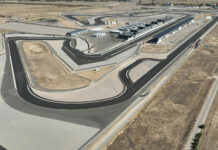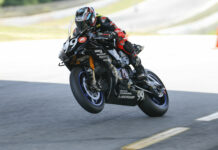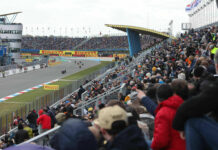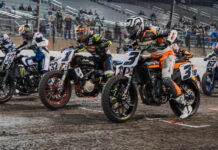Copyright 2002, Roadracing World Publishing, Inc.
Proposed AMA Superbike Rule Changes Draw Criticism From Stakeholders; Riders, Tuners, Team Managers Blast AMA Pro Racing For Lack Of Input Into Proposed New Rules
By David Swarts
On June 27, 2002 AMA Pro Racing released proposed changes for the 2003 AMA U.S. Superbike Championship series. The list of proposed changes included the end of the Pro Thunder class at AMA events after the 2002 season, the eradication of the 250cc Grand Prix class from AMA Nationals after the 2003 season, and changes to the rules governing the Superstock, Supersport and Superbike classes. Although the elimination of two of the AMA series’ six classes is news, the rule changes to allow 1000cc multi-cylinder machines into the Superbike class will have the biggest impact on the future of road racing in America and certainly raised instant controversy over not only the rules themselves but, once again, how AMA Pro Racing is conducting business.
The new rules package was signed off on by the AMA Pro Racing Board of Directors, which consists of Chairman PJ Harvey of PJ1 and members Paul Dean of Cycle World magazine, lawyer Cary Agajanian, Mike Buckley of Dunlop, Ray Blank of Honda and Kevin Schwantz.
“The primary reason for these rules modifications is to help create an environment that allows more teams and riders to participate and be competitive in our premier road-racing championship, AMA Superbike,” an AMA press release quoted AMA Pro Racing CEO Scott Hollingsworth as saying.
“We’ve always believed that AMA Superbike racing should more closely reflect what is selling in the high-performance motorcycle marketplace and these changes should address that.
“Additionally,” the release reads, “the new 1000cc multi-cylinder machines also will be eligible to compete in the AMA Lockhart Phillips Formula Xtreme class, adding incentive for teams to compete in both classes.”
Hollingsworth, as usual, was not present at the AMA Superbike event at Brainerd, Minnesota July 27-30, when the announcement of the 2003 rules proposals was sporadically distributed to AMA credential holders in the form of a memo. That memo said the rule changes were designed with the input of “the AMA Pro Racing Road Race Advisory Board, teams, riders, promoters, media and Pro Racing staff”. But when Roadracing World walked around the Brainerd paddock, we found little agreement with the proposed rule changes, and worse, we found a paddock full of AMA Pro Racing stakeholders, including representatives from nearly every factory-operated and factory-supported Superbike team, factory-supported Formula Xtreme team and top Superbike privateer team, who felt their sanctioning body wasn’t listening to them.
At a Road Racing Advisory Board meeting held Friday night, June 28 at Brainerd, members expressed frustration that they had not been allowed to discuss the proposed rule changes and offer suggestions before they became public. “We’ve been wasting our time going to these meetings,” said one Advisory Board member, who went on to express frustration that no member of the AMA Pro Racing Board of Directors was on site to discuss the thinking behind the new rules package.
The current AMA Superbike rule situation started over a decade ago when Twins, mainly Ducati V-Twins displacing 851cc, were permitted to race against 750cc four-cylinder bikes. Allowed to displace as much as 1000cc, Ducatis were even given a weight advantage, a lower minimum weight limit, until they became more competitive. Although racing history is full of exceptions, like Mat Mladin’s three AMA Superbike Championships on a Suzuki GSX-R750 four-cylinder, it wasn’t long before improved engine technology allowed 1000cc twin-cylinder machines from Ducati, and later Aprilia and Honda, to rev faster than before, produce equal horsepower and more torque than the 750cc Fours and become the dominant engine configuration in national and international Superbike racing. And the 1000cc Twins have dominated for some time now.
Series organizers around the world have been studying this situation for the last several years and only recently began changing the rules to hopefully level the playing field for the present and the future – no easy feat. In May 2001, the British Superbike series, considered one of the top domestic series in the world, made the first change to allow 1000cc four-cylinder bikes to compete against 1000cc Twins. The British rules limited 1000cc fours to FIM Supersport engine modifications, including cylinder head porting, in Superbike chassis. So far in 2002, the formula seems to have mixed results, with 1000cc Fours sharing the podium the Ducati 998RS but with only one win by a rider on a Four.
In May 2002, the FIM and World Superbike organizers announced 2003 rules which will allow 1000cc four-cylinder machines to compete against current 750cc four-cylinder machines and 1000cc Twins but do so with air restrictors (1 x 26.3mm, or 2 x 18.7mm) in the intake tract. Minimum weight limits for each engine configuration have been set with 750cc Fours at 159 kg (350 pounds), 1000cc V-Twins at 162 kg (357 pounds) and 1000cc Fours at 168 kg (370 pounds). Other than the air restrictors, the bikes will have only the normal Superbike engine and chassis modification limits.
The AMA’s plan to integrate 1000cc four-cylinder machines into Superbike racing alongside 750cc four-cylinders and 1000cc twin-cylinders differs from the rule structure of any other sanctioning body. AMA Pro Racing is proposing that current 750cc four-cylinder and 1000cc twin-cylinder Superbikes will be allowed to run in their current state of tune at their current 355-pound minimum weight limit. New for 2003, 1000cc three and four-cylinder machines, or “multis”, will be allowed in America’s premier class with Superbike chassis and weight limits of 360 pounds for Triples and 370 pounds for Fours. (Current Formula Xtreme bikes are required to weigh at least 365 pounds.)
Engine modifications for 1000cc four-cylinder Superbikes will be limited to a strange combination that will allow cylinder heads to be ported and machined with aftermarket cams but linked to stock valves, retainers and, apparently, valve springs. Aftermarket rods will be allowed but with stock pistons, rings, pins and balanced, stock crankshafts. Supersport-spec rules will govern ignition modules, fuel delivery systems and airbox modifications for the multi-cylinder Superbikes with the exception that emissions plumbing can be removed. The 1000cc Fours would also be limited to stock internal gear ratios for their transmissions. Also, all motorcycles would have to be homologated for street bikes for the United States, which would apparently leave out a few motorcycles that currently compete in AMA Superbike.
AMA Pro Racing also announced changes to the rules for Supersport and Superstock, but the reaction to those changes, mainly to allow machining of gasket surfaces of the cases, cylinders and heads and to allow the Ducati 748 twin into the Supersport class, were inconsequential when compared to the proposed Superbike changes.
Kawasaki Road Racing Team Manager Michael Preston said, “With what they proposed, it seems kind of lopsided. The only positive thing I have to say about it is it’s a proposed rule change. We’re disappointed about it, without a doubt, disappointed in communication with the AMA. They didn’t discuss most of the stuff they did with us.”
Yamaha Team Manager/Crew Chief Tom Halverson was very hesitant to speak for Yamaha but did say, “I think it’s obvious the 1000cc (four-cylinder) machines, with these rules, will not be competitive. From our company’s standpoint, I’ll have to get together with Keith (McCarty, Yamaha Racing Manager) and come up with a proposal for the AMA that makes it possible for everyone to win, all factories and competitors.”
“We are very much against the new proposal for fairness and safety. We are not happy. We are asking the AMA to reconsider,” said Masayuki Itoh, American Suzuki Motorcycle Technical Department Manager. “You can see that Formula Xtreme bike is very modified but cannot compete with 750cc Superbike from lap time. Safety: Stock components modified somewhere, (modified) cams with stock piston and valves, engine unbalanced. I feel it would result in motor failures. But I know wide-open 1000cc Fours not fair for 1000cc V-Twins.”
Someone who knows the detailed differences between a factory 750cc Superbike and a factory Ducati Superbike is HMC Ducati Crew Chief Gary Medley. “It’s not gonna help the Inline Fours. It’s gonna hinder them,” said Medley when asked about the proposed rule changes. “Being able to use cams with stock valves isn’t going to work. The stock pistons and rings are too heavy. Plus, an Inline Four needs a different selection of gears to be effective.”
Another long-time factory Superbike tuner with both recent 750cc Inline Four (with Kawasaki) and 1000cc V-Twin knowledge, Honda’s Al Ludington, said, “At the moment, the proposed rule is over restrictive (for the 1000cc Fours). They’ll probably start them out too restrictive, see how the parity is and then go from there. We gotta start somewhere. This is as good a place as any. There’s no way to jump in and be equal.” Ludington’s diplomatic outlook is understandable considering American Honda’s RC51 would continue to race–and likely dominate–as it has during 2002.
Giving credit where credit was due, Ludington pointed out, “You can tell they’re trying to keep costs down. It looks like built-in restrictions on power and cost, but if this were NASCAR, they would already have them (bikes according to the new rules) built and would be testing them.”
Honda Racing Team Manager Chuck Miller echoed some of Ludington’s thoughts, saying, “It’s a good starting point, but there’s a lot of concerns. They had to start somewhere, but it’s hard to get everyone to agree to all the rules. 1000s coming into Superbike was inevitable, but when they do come in, there needs to be parity.
“We all have 30 days to gather our thoughts and voice our opinions. We all won’t submit one proposal, but I don’t think we’ll be far off.”
From the June 27 release date, riders, team owners and other AMA Pro Racing credential holders have 30 days to comment and communicate their feelings concerning the proposed rule changes to the AMA, but that may be where the biggest problem with the whole situation lies, communication.
When asked for possible solutions to the current Superbike rules situation, Kawasaki’s Preston bluntly said, “Get the AMA to start communicating with us, working with the Rules Advisory Committee and all the manufacturers.”
Halverson explained, “At the Advisory Board meeting in December, we were told this was coming. We were allowed to give feedback to the AMA on what should and shouldn’t be in the rules. We thought we would get a chance to see it before it became public. At least see what everyone’s input was and put it together in another step. I feel kind of blindsided by the proposal.
“It’s obvious the guys who are winning right now, that’s not gonna change. The idea was to bring a 1000cc bike in that would be competitive.”
“It’s non-existent,” is what Erion Honda team owner Kevin Erion said when asked about communication with AMA Pro Racing. “We don’t have anyway to communicate with them efficiently. There are people there now (AMA Pro Racing Board of Directors) that weren’t there two years ago that want to change it. But change doesn’t happen overnight. Big wheels turn slowly. We need to be fair with them and hope that they are fair with us. Now the door is open for discussion (30-day comment period). Now it’s up to us to provide information they (AMA Pro Racing) didn’t think of or haven’t heard before.”
When asked if he was consulted by AMA Pro Racing on the proposed changes, Jeff Nash, AMA Board of Directors member, former AMA Pro Thunder Champion, current Pro Thunder team owner (AMS Ducati) and engine builder for Austin/Bleu Bayou Ducati said, “(AMA Pro Racing CEO, Scott) Hollingsworth has never been to a race meeting. Where does he get his feedback, because he’s never here? He’s never come to me.”
Even one top-level AMA Pro Racing official, who didn’t want to speak on the record, commented about the absence of Hollingsworth from the racetrack being a problem for the AMA series.
Along with the memo of proposed rule changes, AMA Pro Racing released an “interview” with their own CEO, Scott Hollingsworth. In the “interview”, Hollingsworth was asked, “Do you think the 1000cc multis will be faster than current Superbikes?”
With little technical motorcycle background compared to the men turning wrenches, building motors and doing dyno runs on a daily basis, Hollingsworth responded with, “No, but we do expect them to be competitive. Current Formula Xtreme technical regulations allow greater modifications than what’s proposed for 1000cc multi-cylinder Superbikes in 2003. But there is a balancing act here. Current Formula Xtreme machines can’t get all of the available power to the ground, and aren’t as nimble as Superbikes, meaning they have lower corner speeds and slower lap times. Because of this, it will take some time for teams to develop these 1000cc multis and close the gap on today’s front runners. In three to five years, we expect the market will evolve to the point where the entire grid will be composed of this type of equipment.”
When asked to respond to Hollingsworth’s statement that Formula Xtreme machines can’t get all the available power to the ground, Team Valvoline EMGO Suzuki Crew Chief Keith Perry said, “Why are we all trying to get more power? Why are we going faster with more power? They want it to weigh five pounds more than a Formula Xtreme bike does now?” Perry’s team won the 2001 AMA Formula Xtreme Championship with approximately 175 horsepower and won the 2002 AMA Formula Xtreme race at Brainerd, their first FX win of the season, thanks in part to a new, 200-horsepower engine.
The Graves Motorsports Yamaha YZF-R7/R1 has been one of the most potent Formula Xtreme bikes in the paddock over the last two seasons in terms of horsepower and chassis, but team owner Chuck Graves simply said, “Formula Xtreme bikes aren’t competitive (with Superbikes).”
Attack Suzuki team owner Richard Stanboli said, “If Formula Xtreme bikes aren’t competitive with Superbikes now, then how will they compete if they’re restricted? I think the stock valve train leads to danger. I don’t think the Superbike guys want to be oiled down by a bunch of built 1000s.”
Erion’s opinion on 1000cc Fours being competitive differed slightly from most others. Erion explained by posing his own questions to be clear and said, “Will the rules that they proposed let 1000cc multis be competitive? No. Given the proper rules, can they be competitive? Yes. Would the current (less restrictive) Superbike rules make Inline Fours competitive? Yes.”
Omitting deteriorating track conditions as a factor, Erion added, “I believe Kurtis Roberts has the (lap) record here (Brainerd) on a (2000) CBR929RR, and those bikes didn’t have as much horsepower (as the 2002 CBR954RRs). Horsepower’s not always the answer to a fast lap around a racetrack.
“I think it’s good to go to 1000cc Inline Fours. Do I like the current rules? No, not the state they’re in. In my opinion, if you allow certain modifications for a racing engine, they need to be compatible top-to-bottom. A chain is only as strong as its weakest link.
“If you allow for high performance cams, you have to allow for a high performance valve train. If you change for higher revs, you need to let us change valves and springs or you’ll have failures. Everything is designed together. They need to allow components to be matched. You can build an engine that makes a bazillion horsepower for one run on the dyno, then it’s done. We build engines to finish races.”
Former factory Superbike rider (Suzuki GSX-R750 and Ducati 996SPS) and current Formula Xtreme rider Steve Rapp said, “If a Formula Xtreme bike can’t be as fast or faster than a Superbike, then it seems like it would be tough for restricted Formula Xtreme bikes to be competitive.”
But maybe the new Superbike rules aren’t for Formula Xtreme teams and riders to move into the Superbike class. Maybe the rules are designed to give the Superbike privateers, who currently race the class on Superstock GSX-R750s fitted with slicks, a better chance to stay with the factory Superbikes as well as race in the Formula Xtreme class?
With this question in mind, we asked the top four privateers in the Superbike point standings, Brian Parriott, Brian Livengood, Rich Conicelli and Andrew “Woody” Deatherage if they were consulted during the conception of the new rule proposals. All four said, “No,” and most laughed at the question, explaining it would be unusual for AMA Pro Racing to consult the privateers for any reason.
When asked if the proposed Superbike rules would help level the playing field between the factory riders and the privateers, Rapp said, “Yeah, instead of getting lapped twice they’ll only get lapped once.”
Asking for solutions in the paddock, it became clear that there was no quick answer to provide competitive racing between several different brands and engine configurations of Superbikes for the present and the future. However, some interesting feedback was offered.
“I think they should let Inline Fours (750cc) be 2mm overbore and let the rest of the rules remain the same,” offered Medley. “The difference between the Kawasaki and the Ducati isn’t horsepower, it’s the torque curve. I know what the horsepower difference will be if you put a 2mm overbore in a Superbike. I know how it works from when we built the Muzzy Raptor. The 835cc was stroked, but we built 2mm-over motors. They were 780cc or somewhere around there. It brought the horsepower and the torque up. If they could bring the torque curve up half to where the Twins are, they would be competitive. The overbore gives the same revs with a higher torque peak lower in the rev range.”
“Pistons. That would help, it wouldn’t be enough, but it would help,” said Perry. “But if you don’t restrict the V-Twins, you’ll be out to lunch.”
Honda proposed one 22mm or two 18mm restrictors in the airbox of all 1000cc Superbikes before the proposed rules were made public to the AMA Pro Racing community, revealed Ludington, who then sarcastically added, “But the AMA is way wiser than any of us could be.”
“Restrictors are not cost effective,” said privateer Deatherage. “You still have to have a built (and expensive) motor with restrictors stuck on them.
“One thing to do for cost help, eliminate telemetry (data acquisition use) on race weekends. Running it in testing would be okay but not at the track on a race weekend. That would level out the playing field somewhat.” Deatherage also believes that factory teams shouldn’t be allowed to use parts that aren’t available to every rider and that some sort of black box swap could help level the field. Current claiming rules in Superbike theoretically allow privateers to the same parts as factory riders, but no privateers want to risk angering the manufacturers by claiming parts from their bikes.
“My opinion is whatever the rules are for cc (displacement), they should be applied for all manufacturers,” stated Graves. “Whatever the limits are, that’s what they are. Manufacturers should build motorcycles that suit the class. It has always been 750. The rules were changed to make a 1000cc Twin legal. That shouldn’t have been done in the first place.”
Under the proposed rules, Nash pointed out, “Homologation would require motorcycles to be originally U.S. street-legal. A street-legal bike in the U.S.? That means there will be no (Yamaha YZF-) R7, no Aprilia (Mille SP), no (Ducati) 998RS, no Benelli. The homologation needs to be through FIM. Is it world or U.S.? It could restrain small manufacturers from being competitive. We need a global formula so people from overseas can come here and race and it will increase our marketability.”
“You can’t disenchant the manufacturers from racing. You can’t have FIM stuff too far from U.S. stuff because you can’t have manufacturers building two different kinds of bikes,” said Erion.
“Speed comes from three things: Chassis, rider skill and money. Factories have more money to spend on talent and the bike itself. As far as Hollingsworth’s statement, 1000cc Fours will not go as fast as Superbikes because of chassis.
“(Future Superbikes) must be a production-based bike, no R1/R7 crap, unlimited modifications to the engine, you can change the clutch but it must be the same style of clutch, wet or dry, standard transmission. Limit bikes with chassis by saying chassis must remain stock appearing from the outside. Inside you can do whatever you want. It will force the manufacturers to produce RR-R chassis. We all know chassis is what’s allowing the Superbikes to go faster.
“World Superbike is using air restrictors, (we’ll use) chassis as restrictors. It’s all subject to what the manufacturers say. Force manufacturers to look at production chassis.”
Erion also feels that with a restructuring of the Formula Xtreme (overall increase) and Superbike (thicker through the middle) purses, privateers could still pay for their racing or make money by building a top-level bike for both Formula Xtreme and Superbike under the proposed rule and class structure. By doing well (top five) in Formula Xtreme and finishing in the top 20 of Superbike, Erion hopes a privateer could take home $7000 – $10,000 in a weekend and pay for his $70,000 1000cc four-cylinder FX/Superbike by the end of the season.
The proposed Superbike rule changes, the “interview” with Hollingsworth and another story concerning the proposal’s announcement can be found at www.amaproracing.com.
AMA stakeholders have until Friday, July 26, 2002 to comment on the proposed changes at www.amaproracing.com/ridersonly, by FAX to AMA Pro Racing – Rules Comment at (614) 856-1924 or mail to AMA Pro Racing – Rules Comment, 13515 Yarmouth Drive, Pickerington, OH 43147. Any feedback should identify which rule is being commented on.






